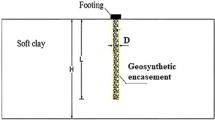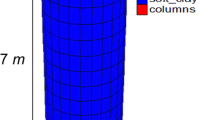Abstract
The use of geosynthetic-encased stone columns as a method for soft soil treatment is extensively used to increase the bearing capacity and reduce the settlement of raft foundations and the foundation of structures like embankments. Pre-strain is an effect occurring in the encasement during stone column installation due to the compaction of the stone material. The present study uses the finite element program Plaxis to perform a numerical analysis of the soft clay bed reinforced by geosynthetic-encased stone columns. An idealization is proposed for simulation of installation of geosynthetic-encased stone columns in soft clay based on the unit-cell concept. In the analyses, initially, the validity of the analysis of the single column-reinforced soil in the unit-cell model was performed through comparison with the group columns. Then, by considering a unit-cell model, the finite element analyses were carried out to evaluate the stiffness of the reinforced ground to estimate the settlement. The results of the analyses show that the improved stiffness of the encased stone column is not only due to the confining pressure offered by the geosynthetic after loading, but the initial strain of the geosynthetic that occurred during installation also contributes to the enhancement of the stiffness of the stone column and the reduction of the settlement.











Similar content being viewed by others
References
Barksdale RD, Bachus RC (1983) Design and construction of stone columns. Report FHWA/RD-83/026, National Information Service, Springfield, Virginia
Deshpande PM, Vyas AV (1996) Interactive encased stone column foundation. Proceedings of the Sixth International Conference and Exhibition on Piling and Deep Foundation, DFI 1996, ISSMFE, Bombay, pp 1–19
Lo SR, Zhang R, Mak J (2009) Geosynthetic-encased stone column in soft clay: a numerical study. Geotext Geomembr 28:292–302
Christoulas S, Giannaros C, Tsiambaos G (1997) Stabilization of embankment foundation by using stone columns. Geotech Geol Eng 15(3):247–258
Hughes JMO, Withers NJ, Greenwood DA (1975) A field trial of reinforcing effects of stone columns in soil. Geotechnique 25(1):31–44
Priebe HJ (1976) Abschactzung des setzungsverhaltns eiens durch stopfverdichtung verbesserten baugrundees. Die Bautechnik 54:160–162, In German
Priebe HJ (1995) The design of vibro replacement. Ground Eng 28(10):31–37
Aboshi H, Ichimoto E, Harada K, Emoki M (1979) The composer—a method to improve the characteristics of soft clays by inclusion of large diameter sand columns. Proceedings International Conference on Soil Reinforcement, Paris, pp 211–216
Goughnour RR (1983) Settlement of vertical loaded stone columns in soft ground. In: Proceedings of the Eighth European Conference on Soil Mechanics and Foundation Engineering, Helsinki, vol 1, pp 23–25
Raithel M, Kempfert HG (2000) Calculation models for dam foundations with geotextile-coated sand columns. Proceedings of the International Conference on Geotechnical and Geological Engineering, Melbourne, Australia, 347
Kempfert HG, Möbius W, Wallis P, Raithel M, Geduhn M, McClinton RG (2002) Reclaiming land with geotextile encased columns. Geotech Fabr Rep 20(6):767–772
Raithel M, Kempfer, HG, Kirchner A (2002) Geotextile encased columns (GEC) for foundation of a dike on very soft soils. Proceedings of the Seventh International Conference on Geosynthetics, Balkema, the Netherlands, pp. 1025–1028
Alexiew D, Brokemper D, Lothspeich S )2005( Geotextile encased columns (GEC): load capacity, geotextile selection and predesign graphs. Proceedings of Geo-frontiers Conference, ASCE Geotechnical Special Publication, Austin, TX, pp. 497–510
Gniel J, Bouazza A (2009) Improvement of soft soils using geogrid encased stone columns. Geotext Geomembr 27:167–175
Pulko B, Majes B, Logar J (2010) Geosynthetic-encased stone columns: analytical calculation model. Geotext Geomembr 29:626–635
Han J, Ye SL (2001) Simplified method for consolidation rate of stone column reinforced foundation. J Geotech Geoenviron Eng 127(7):597–603
Zahmatkesh A, Choobbasti AJ (2010) Settlement evaluation of soft clay reinforced with stone columns using the equivalent secant modulus. Arab J Geosci. doi:10.1007/s12517-010-0145-y
Choobbasti AJ, Zahmatkesh A, Noorzad R (2011) Performance of stone columns in soft clay: numerical evaluation. Geotech Geol Eng. doi:10.1007/s10706-011-9409-x
Mitchell JK, Huber TR (1985) Performance of a stone column foundation. J Geotech Eng ASCE 11(2):205–223
Ambily AP, Grandhi SR (2007) Behavior of stone columns based on experimental and FEM analysis. J Geotech Geoenviron Eng ASCE 133(4):405–415
Malarvizhi SN, Ilamparuthi K (2007) Comparative study on the behavior of encased stone column and conventional stone column. Soil Found 47(5):873–886
Murugesan M, Rajagopal K (2006) Geosynthetic-encased stone columns: numerical evaluation. Geotext Geomembr 24:349–358
Choobbasti AJ, Vahdatirad MJ, Torabi M, Firouzian S, Barari A (2010) Assessment of soil liquefaction potential based on numerical method—a case study of an urban railway project. Arab J Geosci. doi:10.1007/s12517-010-0217-z
Balaam, NP, Poulos HG, Brown PT (1978) Settlement analysis of soft clays reinforced with granular piles. Proceedings of the Fifth Asian Conference on Soil Engineering, Bangkok, Thailand, 81–92
Elshazly HA, Hafez D, Mosaad M (2008) Reliability of conventional settlement evaluation for circular foundations on stone columns. J Ground Improv 26(2):323–334
Guetif Z, Bouassida M, Debats JM (2007) Improved soft clay characteristics due to stone column installation. Comput Geotech 34:104–111
Brinkgreve RB, Vermeer PA (1998) Plaxis-finite element code for soil and rocks analysis. Version 8.2 Rotterdam Brookfield, AA Balkema
Ayadat T, Hanna AM (2005) Encapsulated stone columns as a soil improvement technique for collapsible soil. Ground Improv 9(4):137–147
Hu W, Wood DM, Stewart W (1977) Ground improvement using stone column foundation: results of model tests. Proceedings International Conference on Soil Ground Improvement Techniques, Macau, pp. 247–256
Pulko B, Majes B, Logar J (2011) Reply to the discussion by Khabbazian M, Meehan CL, Kaliakin VN on geosynthetic-encased stone columns: analytical calculation model. Geotext Geomembr 29(1):29–32. doi:10.1016/j.geotexmem, 2011.01.011
Author information
Authors and Affiliations
Corresponding author
Rights and permissions
About this article
Cite this article
Choobbasti, A.J., Pichka, H. Improvement of soft clay using installation of geosynthetic-encased stone columns: numerical study. Arab J Geosci 7, 597–607 (2014). https://doi.org/10.1007/s12517-012-0735-y
Received:
Accepted:
Published:
Issue Date:
DOI: https://doi.org/10.1007/s12517-012-0735-y




